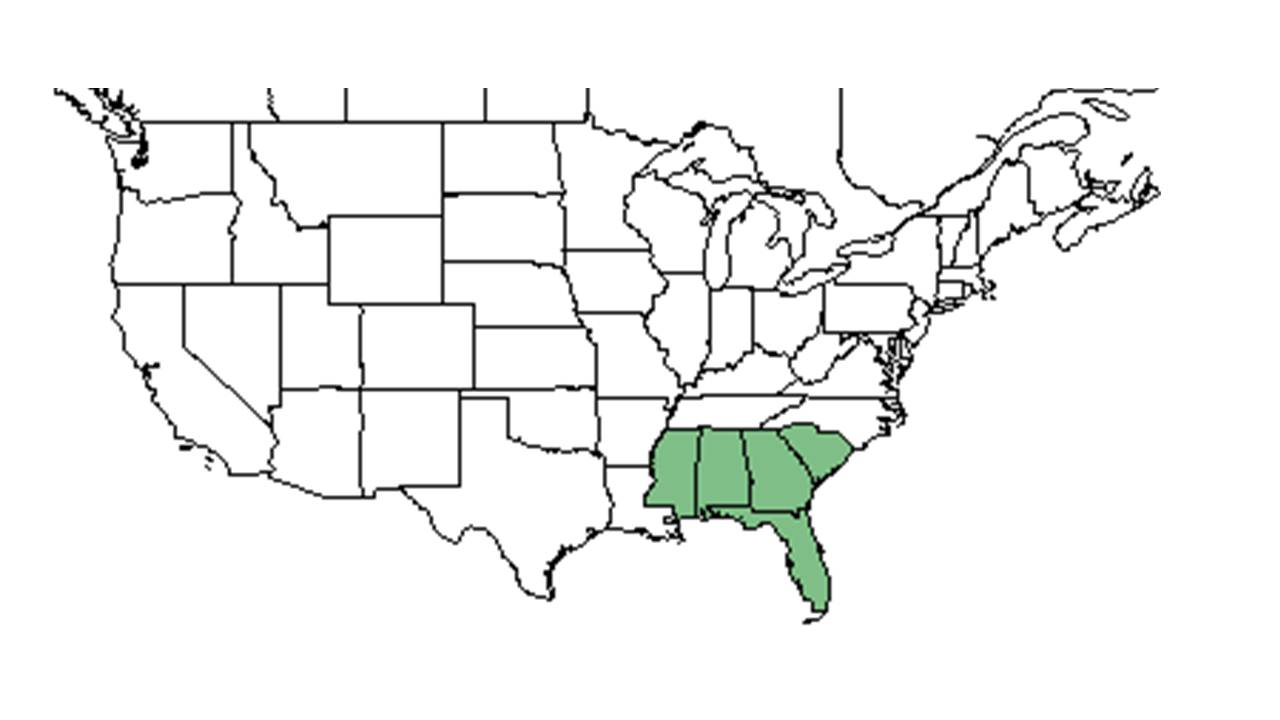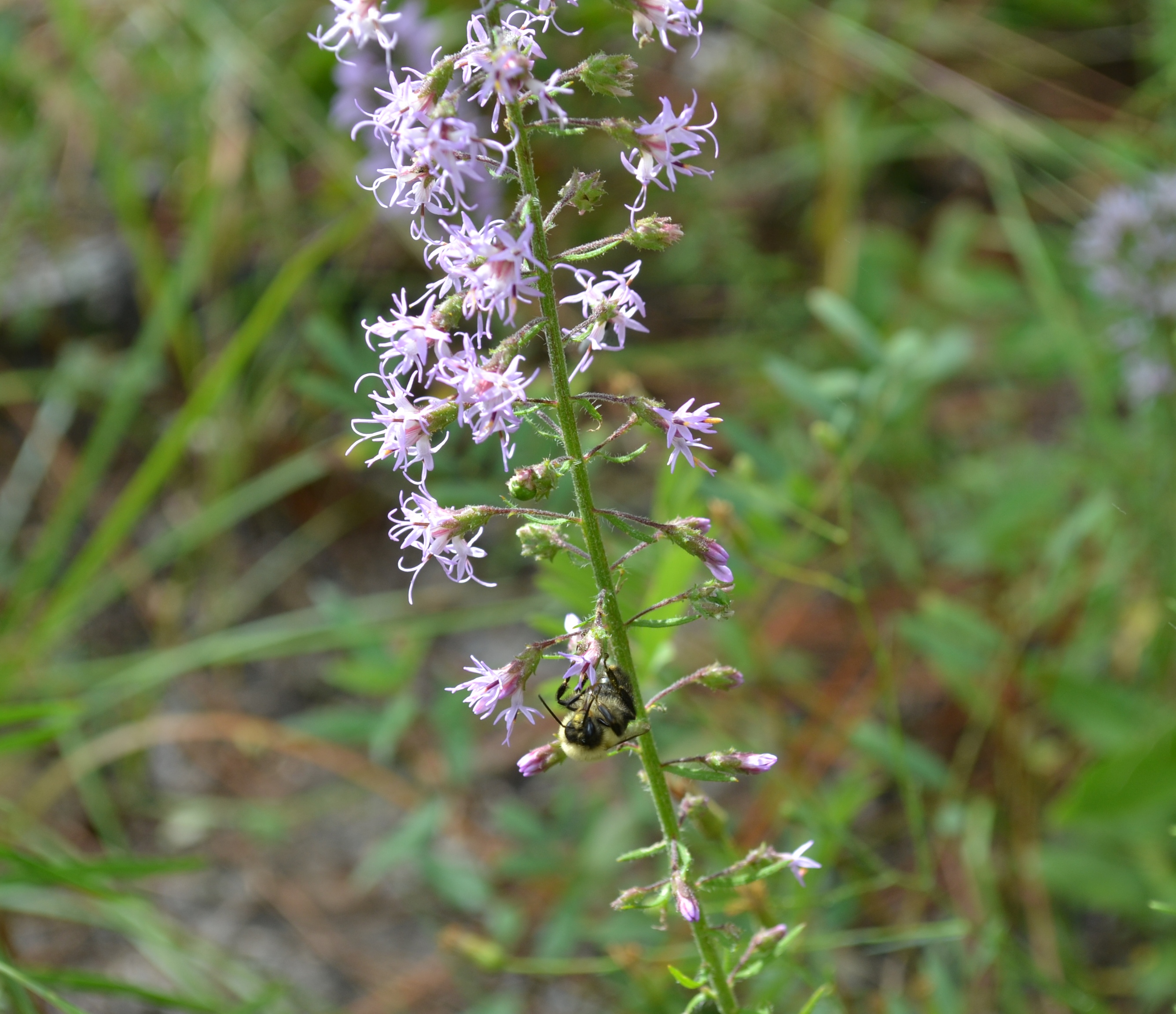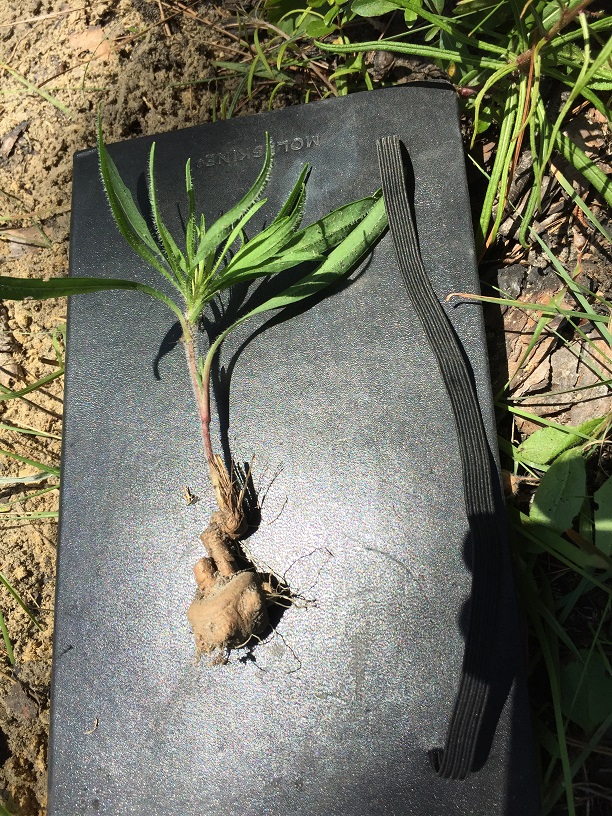Difference between revisions of "Liatris gracilis"
(→Taxonomic notes) |
|||
| Line 20: | Line 20: | ||
Common name: slender blazing star<ref name=weakley>Weakley, A.S. 2020. Flora of the Southeastern United States. Edition of 20 October 2020. University of North Carolina at Chapel Hill, Chapel Hill, North Carolina.</ref> | Common name: slender blazing star<ref name=weakley>Weakley, A.S. 2020. Flora of the Southeastern United States. Edition of 20 October 2020. University of North Carolina at Chapel Hill, Chapel Hill, North Carolina.</ref> | ||
==Taxonomic notes== | ==Taxonomic notes== | ||
| − | Synonyms: '' | + | Synonyms: ''Liatris gracilis'' Pursh var. ''gracilis'' .<ref name="weakley">Weakley, A.S. 2015. Flora of the southern and mid-atlantic states. Working Draft of 21 May 2015. University of North Carolina at Chapel Hill, Chapel Hill, North Carolina.</ref> |
| − | Varieties: | + | Varieties: ''Laciniaria laxa'' Small; ''Laciniaria gracilis'' (Pursh) Kuntzenone.<ref name="weakley">Weakley, A.S. 2015. Flora of the southern and mid-atlantic states. Working Draft of 21 May 2015. University of North Carolina at Chapel Hill, Chapel Hill, North Carolina.</ref> |
==Description== | ==Description== | ||
Revision as of 15:54, 12 June 2023
| Liatris gracilis | |
|---|---|

| |
| Photo taken by Gil Nelson | |
| Scientific classification | |
| Kingdom: | Plantae |
| Division: | Magnoliophyta - Flowering plants |
| Class: | Magnoliopsida – Dicotyledons |
| Order: | Asterales |
| Family: | Asteraceae ⁄ Compositae |
| Genus: | Liatris |
| Species: | L. gracilis |
| Binomial name | |
| Liatris gracilis Pursh | |

| |
| Natural range of Liatris gracilis from USDA NRCS Plants Database. | |
Common name: slender blazing star[1]
Contents
Taxonomic notes
Synonyms: Liatris gracilis Pursh var. gracilis .[1]
Varieties: Laciniaria laxa Small; Laciniaria gracilis (Pursh) Kuntzenone.[1]
Description
A description of Liatris gracilis is provided in The Flora of North America. Liatris gracilis is a perennial herbaceous species. Its stems are pubescent with leaves that are glabrous or pubescent beneath and remotely ciliate. The involucres are pedunculate, cylindric, 5-9 mm long, and 3-7 mm in diameter. The heads are 7-12 flowered with 1-3 cm long peduncles. The nutlets are 2.5-4 mm long with pappus that are 5-6.5 mm long.[1]
The root system of Liatris gracilis includes corms which store non-structural carbohydrates (NSC) important for both resprouting following fire and persisting during long periods of fire exclusion.[2]. Diaz-Toribio and Putz (2021) recorded this species to have an NSC concentration of 370.3 mg/g (ranking 9 out of 100 species studied) and water content of 43.8% (ranking 19 out of 100 species studied).[2]
Distribution
This plant ranges from Southern Carolina, south to southern Florida, and west to Mississippi.[1]
Ecology
Habitat
L. gracilis occurs in moist to dry loamy sand, sandy loam, or sandy clayey soils.[3] It can be found in longleaf pine-wiregrass flatwoods communities, mixed oak-pine woodlands, oak scrub, grasslands, sandhills, limestone outcroppings, and dry hammocks.[3] However, it can also be found in disturbed areas including roadsides, clear-cuts, waste ground, power line corridors, and old fields.[3] Associated species include Liatris elegans, L. chapmanii, L. spicata, L. tenuifolia, Agalinis, Trichostema, Dicerandra, Pinus palutris, Pinus clausa, Carphephorus pseudoliatris, Carya, Pinus elliottii, Carphephorus odoratissimus, C. paniculatus, Chrysopsis, Chrysopsis, Eupatorium, Solidago, Palafoxia, Aristida stricta, Myrica, Quercus virginiana, Serenoa repens, Pityopsis graminifolia var. graminifolia, Xyris, Andropogon, and Sporobolus floridanus.[3]
Liatris gracilis is frequent and abundant in the Clayhill Longleaf Woodlands community type as described in Carr et al. (2010).[4]
Phenology
L. gracilis has been observed flowering in January and July through November, while fruiting has been observed in September through November.[3][5]
Seed dispersal
This species is thought to be dispersed by wind.[6]
Fire ecology
Liatris gracilis occurs in habitat that is maintained by frequent or annual fire,[3] and has been known to persist through repeated annual burns.[7]
Pollination
L. gracilis is a nectar producing plant that is attractive to native pollinators such as bees and butterflies. Songbirds across the longleaf forest will eat the seeds of Slender Blazing Star.[8]
Conservation, cultivation, and restoration
Cultural use
Photo Gallery
References and notes
- ↑ 1.0 1.1 1.2 1.3 1.4 Weakley, A.S. 2020. Flora of the Southeastern United States. Edition of 20 October 2020. University of North Carolina at Chapel Hill, Chapel Hill, North Carolina. Cite error: Invalid
<ref>tag; name "weakley" defined multiple times with different content Cite error: Invalid<ref>tag; name "weakley" defined multiple times with different content Cite error: Invalid<ref>tag; name "weakley" defined multiple times with different content Cite error: Invalid<ref>tag; name "weakley" defined multiple times with different content - ↑ 2.0 2.1 Diaz-Toribio, M.H. and F. E. Putz 2021. Underground carbohydrate stores and storage organs in fire-maintained longleaf pine savannas in Florida, USA. American Journal of Botany 108: 432-442.
- ↑ 3.0 3.1 3.2 3.3 3.4 3.5 Florida State University Robert K. Godfrey Herbarium database. URL: http://herbarium.bio.fsu.edu. Last accessed: June 2014. Collectors: E. S. Ford, R.K. Godfrey, Loran C. Anderson, John Morrill, E. L. Tyson, Kurt E. Blum, D. B. Ward, Gary R. Knight, C. Jackson, H. A. Davis, Samuel B. Jones, Paul L. Redfearn, Jr., R. Kral, Almut G. Jones, Victoria I. Sullivan, R L Lazor, Olga Lakela, J. P. Gillespie, James D. Ray, Jr., Donald G. Randolph, Sidney McDaniel, J. B. Nelson, B. Cooper, Wendy Caster, Kurt E. Blum, John D. Lazor, Wilson Baker, A. F. Clewell, Roy Komarek, E. V. Komarek, T. MacClendon, Boothes, and Chris VanDerpoel. States and Counties: Florida: Alachua, Bay, Calhoun, Citrus, Clay, Columbia, Dade, Dixie, Escambia, Flagler, Franklin, Gadsden, Gulf, Hillsborough, Jackson, Jefferson, Lafayette, Leon, Liberty, Madison, Nassau, Okaloosa, Orange, Pasco, Polk, Santa Rosa, St Johns, Taylor, Union, Wakulla, Walton, and Washington. Georgia: Thomas.
- ↑ Carr, S.C., K.M. Robertson, and R.K. Peet. 2010. A vegetation classification of fire-dependent pinelands of Florida. Castanea 75:153-189.
- ↑ Nelson, G. PanFlora: Plant data for the eastern United States with emphasis on the Southeastern Coastal Plains, Florida, and the Florida Panhandle. www.gilnelson.com/PanFlora/ Accessed: 12 DEC 2016
- ↑ Kirkman, L. Katherine. Unpublished database of seed dispersal mode of plants found in Coastal Plain longleaf pine-grasslands of the Jones Ecological Research Center, Georgia.
- ↑ Robertson, K.M. Unpublished data collected from Pebble Hill Fire Plots, Pebble Hill Plantation, Thomasville, Georgia.
- ↑ Denhof, Carol. 2014. Plant Toothache Grass Slender Blazing Star Liatris Gracilis Pursh. The Longleaf Leader – Denizens of the Longleaf Woodland. Vol. VII. Iss. 3. Page 13

